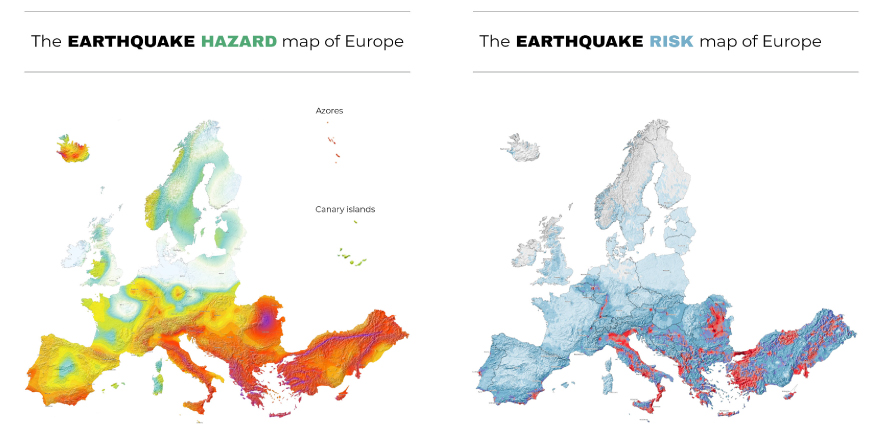New earthquake assessments available to strengthen preparedness in Europe

During the 20th century, earthquakes in Europe accounted for more than 200,000 deaths and over 250 billion Euros in losses (EM-DAT). Comprehensive earthquake hazard and risk assessments are crucial to reducing the effects of catastrophic earthquakes. The newly released update of the earthquake hazard model and the first earthquake risk model for Europe are the basis for establishing mitigation measures and making communities more resilient. They significantly improve the understanding of where strong shaking is most likely to occur and what effects future earthquakes in Europe will have. The development of these models was a joint effort of seismologists, geologists, and engineers across Europe. EFEHR will maintain and further develop these models in future. The research has been funded by the European Union’s Horizon 2020 research and innovation programme.
Earthquakes cannot be prevented nor precisely predicted, but efficient mitigation measures informed by earthquake hazard and risk models can significantly reduce their impacts. The 2020 European Seismic Hazard and Risk Models offer comparable information on the spatial distribution of expected levels of ground shaking due to earthquakes, their frequency as well as their potential impact on the built environment and on people’s wellbeing. To this aim, all underlying datasets have been updated and harmonised – a complex undertaking given the vast amount of data and highly diverse tectonic settings in Europe. Such an approach is crucial to establish effective transnational disaster mitigation strategies that support the definition of in-surance policies or up-to-date building codes at a European level (e.g. Eurocode 8 ) and at national levels. In Europe, Eurocode 8 defines the standards recommended for earthquake-resistant construction and retrofitting buildings and structures to limit the impact due to earth-quakes. Open access is provided to both, the European Seismic Hazard and Risk Models, including various initial components such as input datasets.
The updated earthquake hazard model benefits from advanced datasets
Earthquake hazard describes potential ground shaking due to future earthquakes and is based on knowledge about past earthquakes, geology, tectonics, and local site conditions at any given location across Europe. The 2020 European Seismic Hazard Model (ESHM20) replaces the previous model of 2013.
The advanced datasets incorporated into the new version of the model have led to a more comprehensive assessment. In consequence, ground shaking estimates have been adjusted, resulting in lower estimates in most parts of Europe. With the exception of some regions in western Turkey, Greece, Albania, Romania, southern Spain, and southern Portugal where higher ground shaking estimates are observed. The updated model also confirms that Turkey, Greece, Albania, Italy, and Romania are the countries with the highest earthquake hazard in Europe, followed by the other Balkan countries. But even in regions with low or moderate ground shaking estimates, damaging earthquakes can occur at any time.
Furthermore, specific hazard maps from Europe’s updated earthquake hazard model will serve for the first time as an informative annex for the second generation of the Eurocode 8. Eurocode 8 standards are an important reference to which national models may refer. Such models, when available, provide authoritative information to inform national, regional, and local decisions related to developing seismic design codes and risk mitigation strategies. Integrating earthquake hazard models in specific seismic design codes helps ensure that buildings respond appropriately to earthquakes. These efforts thus contribute to better protect European citizens from earthquakes.
Main drivers of the earthquake risk are older buildings, high earthquake hazard, and urban areas
Earthquake risk describes the estimated economic and humanitarian consequences of potential earthquakes. In order to determine the earthquake risk, information on local soil conditions, the density of buildings and people (exposure), the vulnerability of the built environment, and robust earthquake hazard assessments are needed. According to the 2020 European Seismic Risk Model (ESRM20), buildings constructed before the 1980s, urban areas, and high earthquake hazard estimates mainly drive the earthquake risk.
Although most European countries have recent design codes and standards that ensure adequate protection from earthquakes, many older unreinforced or insufficiently reinforced buildings still exist, posing a high risk for their inhabitants. The highest earthquake risk accumulates in urban areas, such as the cities of Istanbul and Izmir in Turkey, Catania and Naples in Italy, Bu-charest in Romania, and Athens in Greece, many of which have a history of damaging earthquakes. In fact, these four countries alone experience almost 80% of the modelled average annual economic loss of 7 billion Euros due to earthquakes in Europe. However, also cities like Zagreb (Croatia), Tirana (Albania), Sofia (Bulgaria), Lisbon (Portugal), Brussels (Belgium), and Basel (Switzerland) have an above-average level of earthquake risk compared to less exposed cities, such as Berlin (Germany), London (UK), or Paris (France).
Developing the models is a joint effort
A core team of researchers from different institutions across Europe worked collaboratively to develop the first openly available Seismic Risk Model for Europe and to update Europe’s Seismic Hazard Model. They have been part of an effort that started more than 30 years ago and involved thousands of people from all over Europe. These efforts have been funded by several European projects and supported by national groups over all these years.
More information
Downloads & information material

